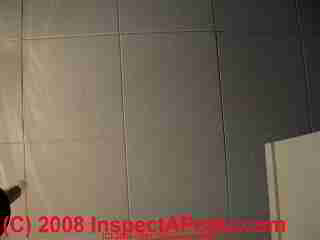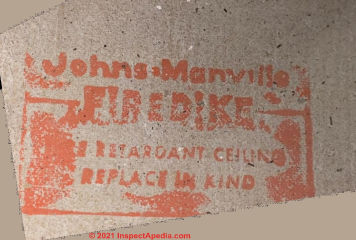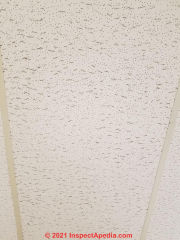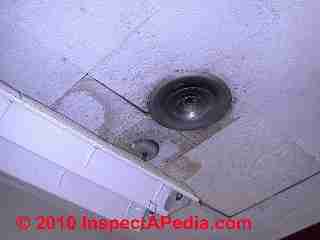 Asbestos in Johns Manville™ Ceiling Tiles ?
Asbestos in Johns Manville™ Ceiling Tiles ?
Do some Johns Manville ceiling tiles contain asbestos?
- POST a QUESTION or COMMENT about how to identify ceiling tiles that contain asbestos
Some sources assert that some Armstrong brand ceiling tiles may contain asbestos:
In this article series we discuss how to recognize & handle ceiling tiles that may contain asbestos.
We describe the appearance, ingredients, years of manufacture, history, and producers of various types of ceiling tiles & coverings as an aid in determining whether or not a particular ceiling covering or tile is likely to contain asbestos.
InspectAPedia tolerates no conflicts of interest. We have no relationship with advertisers, products, or services discussed at this website.
- Daniel Friedman, Publisher/Editor/Author - See WHO ARE WE?
Do Johns Manville Firedike ceiling tiles contain asbestos?
Reader Comments & Q&A on Asbestos in Johns Manville Ceiling Tiles
Also on this page:
Question: do Johns Manville Firedike ceiling tiles contain asbestos?
Can anyone tell me or direct me to info the Johns Manville Fire Dike ceiling tiles. My employer wont let us test them for asbestos, and yet they want us, and have had us, removing mass quantities unprotected.
We are afraid to work with these tiles but need information on the Fire Dike containing asbestos to provide our school why we do not want to work on them unprotected. attached are photos.
thanks Kim - 2021/10/22 Email: pugzilla2@yahoo.com
This is another picture of the Johns Manville Fire Dike from my previous question.
Any help would be appreciated. we are all very fearful, but most are afraid we will loose our jobs if we don't replace when told to.
Kim
Moderator reply: Firedike tiles were reported as made of mineral wool & slag (not asbestos)
@Kim,
Although a great many Johns Manville products made heavy use of asbestos,
“Firedike” is a mineral wool and slag composition used primarily as a, fire-resistant ceiling covering. - Source:
- Smith, Allen C., Early Tests of Drum Type Packagings – The Lewallen Report [PDF] SRNL-STI-2010-00465
PATRAM 2010 Poster 022, p. 3, Savannah River National Laboratory
Savannah River Nuclear Solutions
Aiken, South Carolina 29808
(803) 725 2943, allen.smith@srnl.doe.gov, Note:
Contract No. and Disclaimer: This manuscript has been authored by Savannah River Nuclear Solutions, LLC under Contract No. DE-AC09-08SR22470 with the U.S. Department of Energy. The United States Government retains and the publisher, by accepting this article for publication, acknowledges that the United States Government retains a non-exclusive, paid-up, irrevocable, worldwide license to publish or reproduce the published form of this work, or allow others to do so, for United States Government purposes.
Excerpt: The insulation materials tested were identified by their trade names, “Celotex”, “Fesco”, “Cera Foam”, “Cerafelt”, Vermiculite, and “Firedike.” “Fesco” is a noncombustible roofing insulation. It is a weaker and more brittle material that “Celotex”.
“Cera Form” is an alumina-silica refractory insulating material, stable to 2300 ºF. Its thermal performance was judged to be excellent, but its strength is inadequate to assure a minimum thickness of insulation after a drop test impact. “Cerafelt” is a spun aluminasilica felt with fibers bonded by organic and inorganic binders, with a density of about 6 lb/ft3 . Its thermal performance was judged to be excellent. “
Cera Form” and “Cerafelt” are registered trade names of Johns-Manville Co. “Firedike” is a mineral wool and slag composition used primarily as a, fire-resistant ceiling covering.
Vermiculite is hydrous silicate, usually made by pulverizing mica. It is loose and requires separate support for the inner container.
Those are not asbestos materials.
JM made a range of fire-resistant products in their Firedike line - described in some sources we found asd a "mineral fiber tile rated as part of fire resistive assemblies" with ratings in the 1-4 hours range.
Really? Asbestos is also a mineral. And we don't know if ALL JM Firedike products were composed as described by Smith as given above. And much vermiculite and thus many vermiculite-based products may contain asbestos.
At least for products made through 1977 and possibly later Johns Manville used Firedike (or in some sources “Fire Dike”) as a trade name for mineral-fibre based fire-resistant building materials - ceiling coverings -
- Second source:
- Acoustical Materials Association Performance Acoustical Materials Performance Data Bulletin No. XXVI (1966) [PDF]
[Click to enlarge any image]
Also see VERMICULITE HISTORY & PROPERTIES
It would be prudent to treat any older ceiling of uncertain age (before 1986) and of uncertain materials as presumed to contain asbestos unless you know what it is or have had it tested fdor asbestos.
That doesn't mean it deserves panic; Such materials in good condition, un-damaged, can often be best left in place, perhaps covered over;
You should not chop, grind, saw or otherwise demolish or damage asbestos-suspect ceiling, wall, floor coverings as that would be likely to make a hazardous, asbestos-containing dust.
On 2017-04-22 8 by (mod) -
Toni,
I could not find the NYC document implied by the CAL number you gave, but the Commercial Standard CS-42-49 (class F) fire resistant standard was in some documents used to refer to cellulose-based products (that's wood fiber products) - the standard (now withdrawn) was for fiber insulating board. http://gsi.nist.gov/global/docs/vps/csfiles/cs_42-49.pdf - it doesn't deal with asbestos
If you really cannot simply install a laminate of drywall over the ceiling (best approach) it's worth the <$50. u.s. to have a sample tested. also you might want to send me some sharp photos of the ceiling tiles as well as of their backside and edges when you can obtain that view (along with the lab test result) - our email is at the page top and bottom contact link.
see https://inspectapedia.com/hazmat/asbestos_test_lab_lists.php >
On 2017-04-22 by Toni Dinkel
We have a camp built in the 50s using John's Manville flame resistant glaze coated ceiling tiles. They are off-white with brown edging.
The box says they were approved for use in New York City by the board of standards and appeals under CAL number 1207–40 SM. It also says it was flame resistant coded to meet fire test requirements , US department of commerce commercial standards CS 42-49 (class F). They need to be removed and we wanted to know if they contain asbestos.
(Mar 13, 2015) Sergio Freddson said:
This is a very thorough article! I never realized asbestos was so common in residential homes. I guess I just always assumed it was used more often in commercial buildings. I'll have to double check a few areas in my home for asbestos tiles. Thank you for your advice!
Reply:
Generally asbestos-containing materials such as ceiling tiles are safest left alone and in-place unless the material is damaged, falling down, shedding, leaving debris that can be tracked through a home or otherwise made airborne. It's ok to paint over, encapsulate, seal, or cover-over such materials if occupants prefer. Unnecessary removal is actually more likely to be hazardous than leaving the material alone.
On 2016-08-17 by (mod)
Jon for space and to permit citations I answer your question at JOHNS MANVILLE CEILING & WALL PANELS at https://inspectapedia.com/hazmat/Asbestos-in-Johns-Manville-Ceiling-Tiles.php in the article above.
If you can send me some sharp photos of the tiles/panels front, back, edge, any markings or stampings, and any packaging I can research more completely and it'd be most helpful. Find my email at the page bottom or top CONTACT link.
Daniel
On 2016-08-16 by Jon
I truly apologize for the double post,feel free to delete the bottom one:
Hi there, i recently found a 3 stacked pile(5 ft stacks) on my basement of 2x2 suspended ceiling tiles/panels. they look like the everyday ones that have on a office building ceiling. white on the facing(with 2 different sized pinholes and groves),tan on the back. the ONLY info that has stamped (in red ink) is the following:
Johns-manville corp Pat. D-213367
I have tried and tried to find ANY info about them(online)on the chances that they might contain asbestos.some of the tile look tan in the middle ,some look gray. i want to get rid of them,but BEFORE i move them,i want to make sure that they arent ACM. ANY answer will be greatly appreciated.
Do 2' x 4' Armstrong Ceiling Panels made in 1976 contain Asbestos?
I have a recreation room that uses 2' x 4' Armstrong Ceiling Panels made in 1976 or later. They claim to be fire retardant, and are of the Scotch Pine variety. Do they contain Asbestos? - Mark Webb 2/1/12
Reply: no, according to Armstrong, their ceiling tiles never contained asbestos. Citations provided.
Mark, unfortunately there were so many ceiling products, styles, and names that I've found it almost impossible to build a comprehensive list of asbestos and non-asbestos-containing products.
Reading opinions about asbestos-risks in ceiling tiles discussed at legal services websites and at some home inspection websites either leaves you convinced of a serious asbestos hazard, or delivered a disclaimer recommending testing, encapsulation, or other "safe" advice from inspectors.
Let's sort through the question with a bit more specific or authoritative information:
Who says ceiling tiles contain asbestos?
Suspended ceiling tiles of the 2'x2' or 2'x4' dimension, and manufactured by Armstrong, Celotex, Conwed, LoTone, and USG and made before the late 1970's are listed by several attorney-sponsored "mesothelioma websites" as often containing asbestos to add fire-resistance.
On that basis, since the age of your ceiling is in that range it would be prudent to treat it as PACM.[9]
Who says play it safe about asbestos in ceiling tiles ?
We do, for one. Some ceiling tiles have been widely enough reported to contain asbestos that using some common sense is certainly appropriate: meaning don't make a dusty mess, don't demolish a ceiling of unknown materials without taking proper precautions, and if you are faced with a significant ceiling-renovation or cleanup expense, and if you can't tell for sure by visual inspection that ceiling tiles are asbestos free, have a sample tested.
Some home inspection clubs and open-associations focus almost entirely on using a disclaimer or on giving clients advice that is safe for the inspector and that may be safe for the client, though not necessarily safe for their walled.[10]
Who says their ceiling tiles don't contain asbestos? Armstrong Corporation.
According to Armstrong Corporation, those attorneys and some home inspectors are mistaken. Armstrong commented as follows:
Our mineral fibre tiles are made from a combination of the following naturally occurring, processed and recycled materials in varying proportions depending upon the tile type: mineral wool, clay, perlite, cellulose and starch mixed together in a water based process before being cured by heat.
They are then finished with a water based paint, or laminated scrim and paint, decorative facing. All these materials are environmentally safe and our factories comply with ISO 14001.
Asbestos, in any form, is not and never has been used in the manufacture of Armstrong ceiling tiles.[8]
In general, for ceiling materials of the age you describe, for other brands and without other explicit information from the manufacturer, unless it is quite obvious by visual inspection that the materials are fiberglass or another non-asbestos material, the best answer is to be prudent: treat the material as presumed-asbestos-containing material (PACM) - which means don't make a dusty mess.
2'x4' ceiling tiles are usually drop-in panels in a suspended ceiling grid and are easily swapped out with minimal disturbance or dust if they are damaged, soiled, or need replacement.
...
Continue reading at ASBESTOS CEILING TILE REMOVAL PROCEDURES or select a topic from the closely-related articles below, or see the complete ARTICLE INDEX.
Or see these
Recommended Articles
- ASBESTOS CEILING TILE IDENTIFICATION
- CEILING TILE HISTORY / DATES - asbestos ceiling tile history & dates
- CEILING TILE MANUFACTURER ID
- ASBESTOS-FREE CEILING TILES
- CEILING TILE INGREDIENTS
- CEILING TILE REMOVAL PROCEDURES
- CEILINGS, DROP or SUSPENDED PANEL
- ASBESTOS CEILING TILE IDENTIFICATION - 5 Easy Steps to tell if CEILING TILES are likely to contain asbestos
- ASBESTOS-FREE CEILING TILES
- ASBESTOS PRODUCING COMPANIES & TRUSTS - complete list of Johns-Manville asbestos-containing products
- ASBESTOS-SUSPECT CEILING COVEROVER
- ASBESTOS TESTING LAB LIST - certified asbestos testing labs
Suggested citation for this web page
JOHNS MANVILLE CEILING & WALL PANELS at InspectApedia.com - online encyclopedia of building & environmental inspection, testing, diagnosis, repair, & problem prevention advice.
Or see this
INDEX to RELATED ARTICLES: ARTICLE INDEX to ASBESTOS HAZARDS
Or use the SEARCH BOX found below to Ask a Question or Search InspectApedia
Ask a Question or Search InspectApedia
Try the search box just below, or if you prefer, post a question or comment in the Comments box below and we will respond promptly.
Search the InspectApedia website
Note: appearance of your Comment below may be delayed: if your comment contains an image, photograph, web link, or text that looks to the software as if it might be a web link, your posting will appear after it has been approved by a moderator. Apologies for the delay.
Only one image can be added per comment but you can post as many comments, and therefore images, as you like.
You will not receive a notification when a response to your question has been posted.
Please bookmark this page to make it easy for you to check back for our response.
Comments
IF above you see "Comment Form is loading comments..." then COMMENT BOX - countable.ca / bawkbox.com IS NOT WORKING.
In any case you are welcome to send an email directly to us at InspectApedia.com at editor@inspectApedia.com
We'll reply to you directly. Please help us help you by noting, in your email, the URL of the InspectApedia page where you wanted to comment.
Citations & References
In addition to any citations in the article above, a full list is available on request.
- [12] Wikipedia Web: https://www.wikipedia.org/ provided background information about some topics discussed at this website provided this citation is also found in the same article along with a " retrieved on" date. NOTE: because Wikipedia entries are fluid and can be amended in real time, we cite the retrieval date of Wikipedia citations and we do not assert that the information found there is necessarily authoritative. Web search 6/30/12: "Ceiling Tiles"
- [16] Steven Mlynarek, Morton Corn, Charles Blake, "Asbestos Exposure of Building Maintenance Personnel", Regulatory Toxicology and Pharmacology, 23, 213–224 (1996) ARTICLE NO. 0045, http://library.certh.gr/libfiles/PDF/GEN-PAPYR-4810-ASBESTOS-by-MLYNAREK
-in-RTAP-VOL-23-ISS-3-PP-213-224-Y-1996.pdf - [18] U.S. Environmental Protection Agency (USEPA—Green Book) (1990). In Managing Asbestos in Place: A Building Owners Guide to Operations and Maintenance Programs for Asbestos-Containing
- [28] D. Auribault, "Note sur l'Hygiène et la Sécurité des Ouvriers dans les Filatures et Tissages d'Amianté (On hygiene and security of the workers in the spinning and weaving of asbestos)" in Le Bulletin de l'Inspection du Travail, 1906, pp 120–132.
- [29] Wikipedia entry on Asbestos and various citations from that article, web search 6/30/12, original source: en.wikipedia.org "Asbestos"
- Asbestos Identification and Testing References
- Asbestos Identification, Walter C.McCrone, McCrone Research Institute, Chicago, IL.1987 ISBN 0-904962-11-3. Dr. McCrone literally "wrote the book" on asbestos identification procedures which formed the basis for current work by asbestos identification laboratories.
- Stanton, .F., et al., National Bureau of Standards Special Publication 506: 143-151
- Pott, F., Staub-Reinhalf Luft 38, 486-490 (1978) cited by McCrone
- EPA Guidance for Controlling Asbestos-Containing Materials in buildings, NIAST, National Institute on Abatement Sciences & Technology, [republishing EPA public documents] 1985 ed., Exposure Evaluation Division, Office of Toxic Substances, Office of Pesticides and Toxic Substances, U.S. Environmental Protection Agency, Washington,D.C. 20460
- In addition to citations & references found in this article, see the research citations given at the end of the related articles found at our suggested
CONTINUE READING or RECOMMENDED ARTICLES.
- Carson, Dunlop & Associates Ltd., 120 Carlton Street Suite 407, Toronto ON M5A 4K2. Tel: (416) 964-9415 1-800-268-7070 Email: info@carsondunlop.com. Alan Carson is a past president of ASHI, the American Society of Home Inspectors.
Thanks to Alan Carson and Bob Dunlop, for permission for InspectAPedia to use text excerpts from The HOME REFERENCE BOOK - the Encyclopedia of Homes and to use illustrations from The ILLUSTRATED HOME .
Carson Dunlop Associates provides extensive home inspection education and report writing material. In gratitude we provide links to tsome Carson Dunlop Associates products and services.





